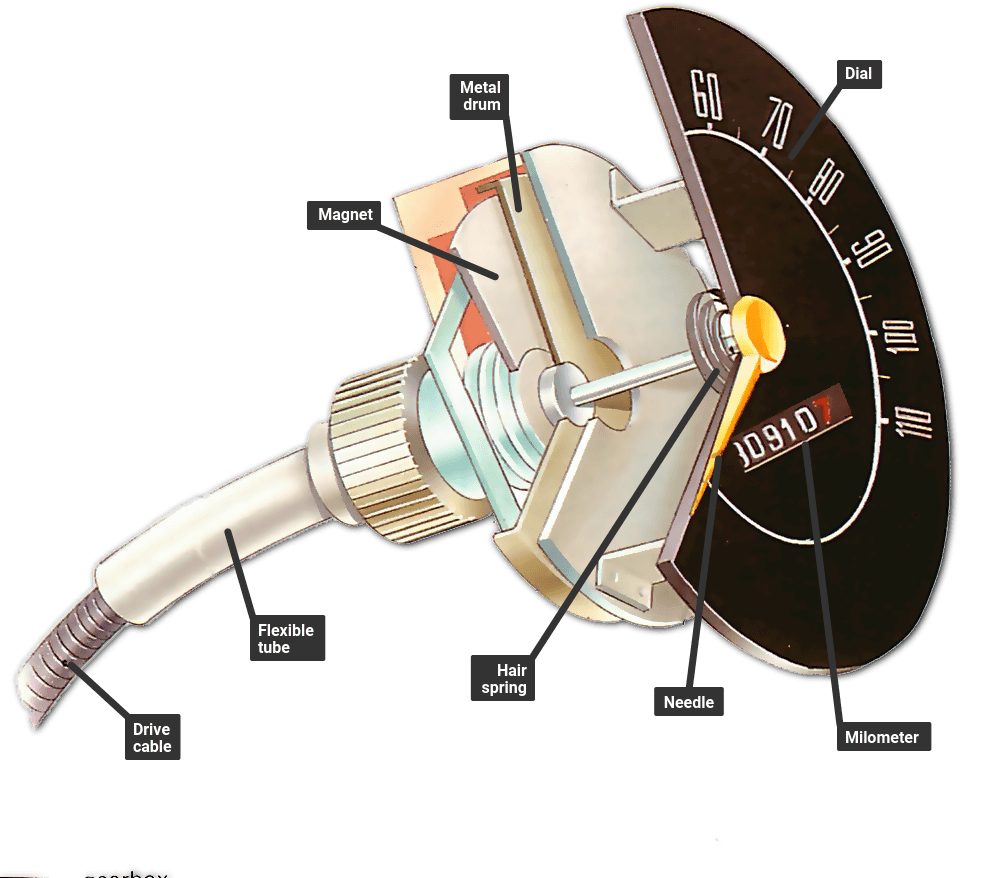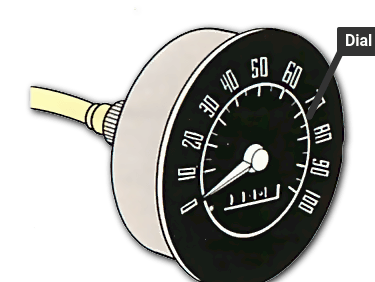How a speedometer works
The Video Course teaches you everything about modern cars.

Of all the instruments you can find on a modern car dashboard , only one is a legal requirement - the speedometer and its built-in milometer (also called an odometer ).
In common with other developments in car technology, the trend is now towards using electronics in speedometers. But most cars - even ones being built today - have a mechanical speedometer, usually with a needle and calibrated dial to show the speed. The design of this type of speedometer has hardly changed in the last 50 years.
Operation
Mechanical speedometers measure the speed of a car by being linked mechanically with the gearbox output shaft . Since this shaft lies 'downstream' of the gear box, the speed with which it rotates is independent of gear changes and so gives a true measure of the road speed.

Inside the gearbox, the output shaft contains a gear wheel which rotates with the shaft. Linked to this gear wheel, and driven by it, is a small pinion gear , the speedometer chive pinion, which links in turn to the speedometer cable that runs up to the speedometer itself.
The speedo cable consists of an inner cable running inside a protective outer sheath. The ends of the speedometer inner cable are squared off, and fit into squared holes in the drive pinion at the gearbox and the drive in the back of the speedometer. As the pinion rotates, driven by the gearbox output shaft, it causes the inner cable to rotate with it.
The other end of the cable fits to a drive shaft leading into the speedometer. On the end of this shaft is a magnet. Positioned close to (but not touching) the magnet is a cup-shaped metal drum that is attached to the needle giving the reading on the dial. A small coiled hair spring holds the needle at zero.

The drum is attracted by the magnet so, as the magnet turns, the drum turns too. The faster the car is travelling, the greater the pull of the magnet on the metal drum and the further the needle moves round the dial. But the restraining force of the hair spring also increases as the needle moves round the dial. At a certain point the forces of the spring and the magnet balance out and the needle steadies to give a reading.
Variations
The two other common types of mechanical speedometer give the reading by a bar or a mark moving along a straight calibrated scale .
Both are roughly similar in operation to the round dial type of speedometer - a cable driven by the gearbox output shaft turns a magnet which causes some sort of indicator to move against the force of a restraining hair spring.

In one type the indicator consists of a moving ribbon attached at each end to a spool. The magnet causes the ribbon to reel off one spool to the other against the force of the hair spring. As the ribbon moves, a mark on it lines up with the calibrated scale to give a reading.

The other type of indicator using a straight scale rather than a dial has a barrel marked with a line. The magnet causes the barrel to rotate until stopped by the hair spring. Again, as the barrel moves, the mark on it lines up with the scale to indicate the speed.
On both these types of speedometer the ribbon or barrel is usually a different colour on each side of the marker line to make the speed easier for the driver to read.
Electronic speedos
In common with the trend towards electronic dashboard instruments, electronic speedometers are now becoming much more popular, even though mechanical ones are generally reliable.
The most common type has a magnet attached to the gearbox output shaft and an electronic unit positioned close by to act as a pickup. Every time the rotating magnet passes the pick-up unit, the unit sends a pulse of electric current down a wire to the speedometer. An electronic 'black box' inside the speedo uses these impulses to calculate the speed of the car.
The Ultimate Car Mechanics video course
Learn everything about modern cars from our new video series.
Learn more >-
We build a Mazda MX5 Miata from scratch
We start by tearing down and then rebuilding the whole car.
-
Every part explained
There's ridiculous detail on every part. Clearly and easily explained.
-
All modeled in 3D
We've created the most detailed 3D model ever produced so we can show you everything working.






